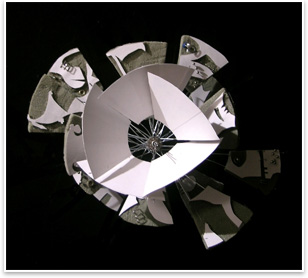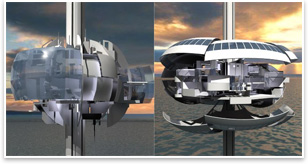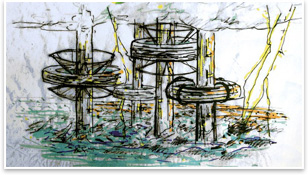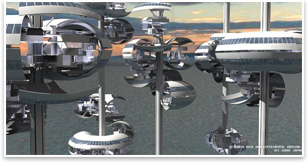Facility at Sea Employs Sustainability and Biomimicry
Clamshell design opens to the elements
by Heather Livingston
Contributing Editor
Summary: While pursuing his master’s degree at the University of Texas, Arlington, Jason Mellard, Assoc. AIA, LEED AP, designed an aquatic research and housing facility to be located 50–100 miles offshore. Citing the Star Wars films, Santiago Calatrava, and offshore oil platforms as inspiration, Mellard’s structure was intended to be a prototype for studying marine and avian life out at sea.
 The project was developed in a studio that explored in depth the George Lucas film Star Wars. Looking at that movie and evaluating its structural designs, the students were tasked with creating a structure that was fantasy in its ability to be constructed at that moment in time, but still grounded in sound design principles. “We analyzed the images from Star Wars and the different iterations based on that,” explains Mellard. “Santiago Calatrava does a lot of kinetic projects that transform from one shape to another and has [elements] like wings that go up, but 50 years ago, you wouldn’t have thought it was possible. I wanted to have it based where conceivably, with enough money and ingenuity, it’s something that could happen but also be far enough out there that it was interesting.” The project was developed in a studio that explored in depth the George Lucas film Star Wars. Looking at that movie and evaluating its structural designs, the students were tasked with creating a structure that was fantasy in its ability to be constructed at that moment in time, but still grounded in sound design principles. “We analyzed the images from Star Wars and the different iterations based on that,” explains Mellard. “Santiago Calatrava does a lot of kinetic projects that transform from one shape to another and has [elements] like wings that go up, but 50 years ago, you wouldn’t have thought it was possible. I wanted to have it based where conceivably, with enough money and ingenuity, it’s something that could happen but also be far enough out there that it was interesting.”
 Biomimicking the clam Biomimicking the clam
Mellard’s research facility is conceived as a temporary live/work environment for scientists studying marine and bird life offshore. Scientists and their families would stay aboard the station in 6–12 month rotations. A strong central trunk anchors the structure, providing mechanical services and vertical circulation. From that trunk extrude three structures that move vertically: two research spheres and a habitation disk. Incorporating the principles of biomimicry, the three structures resemble a clam in its shell by opening and closing as weather allows.
 The research spheres consist of laboratories, classrooms, computer labs, viewing platforms, holding tanks, offices, and storage. The habitation disk provides sleeping and living areas for researchers and their families, communal dining and food preparation, a medical clinic, recreational areas, observation decks, and docking platforms. The mechanical spine houses vertical circulation, energy storage, waste removal systems, a control and engine room, and emergency generators. The research spheres consist of laboratories, classrooms, computer labs, viewing platforms, holding tanks, offices, and storage. The habitation disk provides sleeping and living areas for researchers and their families, communal dining and food preparation, a medical clinic, recreational areas, observation decks, and docking platforms. The mechanical spine houses vertical circulation, energy storage, waste removal systems, a control and engine room, and emergency generators.
 The spherical research laboratories were designed to be submerged below sea level, providing ample and unique opportunities for marine study. When the wind and surface waters become dangerously strong, the other structures also could be sealed via air lock and submerged below sea level to a safe distance. In addition, the habitat rings can be allowed to float on the water’s surface, with portions able to extend out and detach from the central core, becoming an independent vessel that could travel to land or other destinations on the water. The spherical research laboratories were designed to be submerged below sea level, providing ample and unique opportunities for marine study. When the wind and surface waters become dangerously strong, the other structures also could be sealed via air lock and submerged below sea level to a safe distance. In addition, the habitat rings can be allowed to float on the water’s surface, with portions able to extend out and detach from the central core, becoming an independent vessel that could travel to land or other destinations on the water.
Self-sustainability
The facility would need to be self-sustaining for long periods of time to be viable. To provide adequate energy to power the high wattage research labs and accompanying structure, the mechanized shells would harness wind energy using a rotating pinwheel design and collect solar rays through integrated PV cells. In addition, electricity could be generated from the ocean current and the trunk itself could act as a lighting rod that reaches into the sky to attract electricity to storage batteries.
 Constructed primarily of non-corrosive steel and glass, Mellard estimates that to build the structure in today’s dollars would cost $500 million to $1 billion, or the rough equivalent to the cost of building the tallest skyscraper. Multiple housing disks and research spheres could be located off the main vertical trunk, allowing thousands of residents to live in the facility. Each disk accommodates 1,000 people, he explains, and the shafts could, in theory, extend into the clouds. Constructed primarily of non-corrosive steel and glass, Mellard estimates that to build the structure in today’s dollars would cost $500 million to $1 billion, or the rough equivalent to the cost of building the tallest skyscraper. Multiple housing disks and research spheres could be located off the main vertical trunk, allowing thousands of residents to live in the facility. Each disk accommodates 1,000 people, he explains, and the shafts could, in theory, extend into the clouds.
|






